Introduction
This document is an introduction to Unified Computing System (UCS) Mini.
Prerequisites
Cisco recommends that you have knowledge of these topics:
Requirements
- UCS Manager software, Release 3.0, which supports only Cisco UCS Mini
- The Cisco UCS Manager Graphical User Interface (GUI) is a Java-based application which requires a 1.6. x or 1.7. x version of the Java Runtime Environment (JRE).
- Cisco UCS Manager supports the following web browsers:
 Microsoft Internet Explorer 9.0 or higher
Microsoft Internet Explorer 9.0 or higher
 Mozilla Firefox 7.0 or higher
Mozilla Firefox 7.0 or higher
 Google Chrome 14.0 or higher
Google Chrome 14.0 or higher
- Adobe Flash Player 10 or higher is required for some features
- Cisco UCS Manager is supported on the following operating systems:
 Microsoft Windows 7 with minimum 4.0 GB memory
Microsoft Windows 7 with minimum 4.0 GB memory
 Red Hat Enterprise Linux 5.0 or higher with minimum 4.0 GB memory
Red Hat Enterprise Linux 5.0 or higher with minimum 4.0 GB memory
- Cisco UCS Central, Release 1.2 or newer is required for use with Cisco UCS Manager, Release 3.0.
Configure
The Cisco UCS Mini extends the Cisco UCS architecture into environments with requirements for smaller domains.
With UCS Mini, the Fabric Interconnect (FI) 6324 has been collapsed into the IO Module form factor.
Fabric Interconnect-6324 implies that there are twenty-four 10G ports available on it.
Sixteen are server facing (internal), two 10G interfaces dedicated to each of the eight half width blade slots.
The remaining eight interfaces are divided into a group of four 1/10G Enhanced Small Form-Factor Pluggable (SFP+) interfaces and one 40G Quad Small Form-factor Pluggable (QSFP) interface which is called the ‘scalability port’ which is a licensed port.

Instead of inserting Input/Output (IO) Modules into the chassis you now insert the Fabric Interconnects into it.

The 40Gbit interface (Scalability Port) can be used with a breakout cable that transforms to 4 x 10Gbit cables.

The breakout cable is shown below
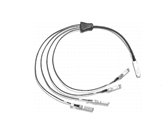
Similar to the 6200 series, the 6324 also has unified ports.
However, only the 4 fixed ports are unified and can be configured as fiber channel or ethernet ports.
The 40Gbit interface can be used for server connections/storage connections and it is called a Scalability Port in the UCS Manager as well.

The Cisco UCS 6324 Fabric Interconnect embeds the connectivity within the Blade Server Chassis to provide a smaller domain of up to 15 servers (8 blade servers and up to 7 direct-connect rack servers)
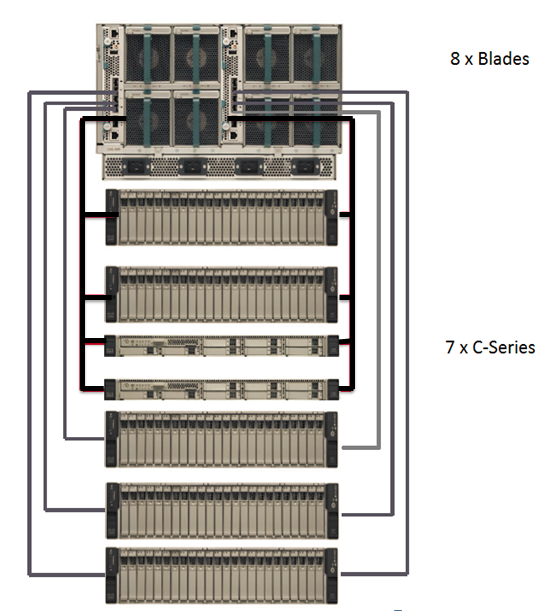
Note: With UCSM Release 3.0, meant for UCS Mini, only B200 M3, C220-M3 and C240-M3 are supported.
Supported Features
All features supported in UCSM 2.2.1 will be supported in 3.0, with the below exceptions
Unsupported Features:
- Ethernet Switching Mode
- Fibre Channel (FC) End Host Mode
- Private VLANs
- Port Security
- Keyboard/Video/Mouse (KVM) Virtualization
New Features:
- Dual Line PSU
- Universal Serial Bus (USB) Support
- QSFP+ (Scalability Port) Breakout Support
- HTML5 GUI (Java GUI continues to be supported)
Configuring Unified Ports (4*10G Ports)
- All FC ports must be contiguous.
- All Ethernet ports must be contiguous.
- FC ports must come before Ethernet ports in the order [1 ..to..4]
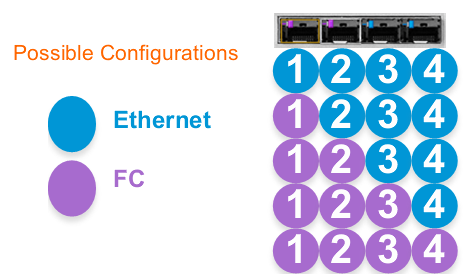
Note: You cannot alternate between Ethernet and FC, as the above configuration clearly depicts.
An example of configuring 1st two ports as FC and remaining two as Ethernet, is as shown below

The Unified ports are numbered Eth 1/1 - 4
The Scalability ports are numbered Breakout Ethernet (Br-Eth)1/5/1 - 1/5/4

FI Swaps
a. Valid swaps
- You could swap FI-A with FI-B on the same chassis

- You could swap both FI-A and FI-B in question with FI-A and FI-B from another chassis

- You could cross swap FI-A and FI-B in question with FI-A and FI-B from another chassis
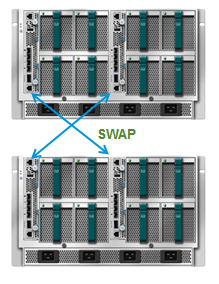
Note: All the above swaps are valid because the cluster instance ID's would match in all the cases.
b. Invalid Swaps
- You cannot swap just FI-A from the chassis in question with FI-A from another chassis

- You cannot swap just FI-A from the chassis in question with FI-B from another chassis
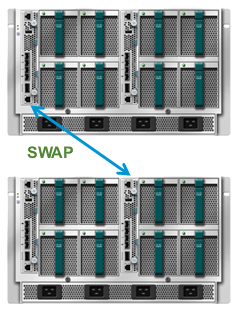
The above swaps are invalid because the cluster instance ID's would not match in either cases, as shown

In order to recover
- Undo the swap (or)
- Erase config on one side and recluster
Supported Topologies
a. IP Based Connectivity
The UCS Mini can be connected to upstream switches via a normal port-channel, independent links or via VPC as shown


b. Direct Attached Storage
iSCSI/FC/FCoE direct attached storage is supported
On the scalability port only FCoE storage is supported and not FC.
Since NPV mode is not supported in 3.0 release, connecting 3rd party FC switches running in switch mode is not supported.

A few other topologies of how UCS Mini could be used with Direct Attached Storage are as listed:


USB Support
- A USB port is provided on the FI (6324)
- It could take up to a minute to detect the insertion/removal of the USB key.
- A Cisco USB key needs to be purchased separately.
- 3rd party USB keys should work, but are not supported.
When the USB is inserted the section on the FI where it gets inserted, it highlighted with a green rectangle.
Select the Remote File System radio button, you should be able to see the USB a/b radio button.
Note: usb a and usb b are for either sides, firmware can be downloaded from either of them.

HTML5 User Interface
This was introduced to eliminate the pain involved in maintenance of JRE Desktop versions (i.e., java upgrades in the past have resulted in the UCSM not opening up etc) by migrating to a browser based technology.
The below screen shows the splash page of the UCSM, Java is still an option in addition to HTML as seen

The browser versions supported for HTML5 are
Internet Explorer - 10+
Firefox - 25+
Chrome - 30,31,32
Safari 7+
Opera 19+
The HTML5 User Interface for UCSM and KVM Launch Manager are as shown below

